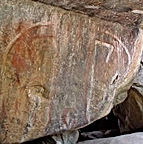
Elk Mound
Bigfoot Research Center

Skookum cast

The Skookum cast is a plaster cast often claimed to be an imprint of the body of Bigfoot, although it is more typically regarded as that of an elk.
The cast was taken on September 22, 2000, during a Bigfoot Field Researchers Organization (BFRO) expedition to the Skookum Meadows area of the Gifford Pinchot National Forest in Washington state, during filming of the now-cancelled Animal-X television show.
The cast, which measures 3.5 by 5 feet (1.1 m × 1.5 m) and weighs approximately 400 pounds (180 kg), is of a partial body imprint left in roadside mud. Impressions of hair are evident on the cast. The body dimensions of the cast are reportedly 40 to 50 percent larger than that of a six-foot tall human. On the same expedition of the BFRO there was evidence of 17 inch footprints that may have belonged to a Sasquatch as well. Many individuals, including the co-founder of the BFRO, Ron Schaffner, recognized several anatomical features that led them to conclude it was made by a resting elk. The cast apparently reveals landmarks that can be recognized as the hindlegs, hip, chest, and wrists of a reclining elk. Cleaning the cast revealed finer details, including "extensive impressions of hair on the buttock and thigh surfaces", and what appears to be longer hair along the forearm. Alternatively, it has been said by some Bigfoot enthusiasts to show the imprint of a forearm, hip, thigh, heel and ankle, and Achilles tendon of a reclining Sasquatch. Impressions of hair are evident on the buttocks and thigh surfaces of the cast, as well as much longer fringes of hair on the forearm region. Dermal ridges appear on the heel, with many of the same characteristics consistently found on other purported Sasquatch samples. Dermal ridges have been alleged to occur on a "heel," but these have been interpreted as hair impressions from the wrist of an elk. A number of elk hoof imprints and coyote paw prints are also present.
Elk and bear hair was found in the cast. Henner Fahrenbach, a retired biomedical researcher from Beaverton, Oregon, analyzed some hairs and claims to have identified a single specimen, which he believes belongs to a Sasquatch, although he admits this identification is very tentative and impossible to test.
There are multiple interpretations as to what the cast represents. Impressions of the elk's wrists were studied by anthropologist Jeffrey Meldrum of Idaho State University, and his interpretation of their anatomy matches his hypothetical models of a Sasquatch foot. Others note a much stronger similarity between the imprints and an elk's wrist and metacarpal impression. This perspective received support through the lack of "Bigfoot footprints" in the immediate vicinity.
The cast has been examined by several Sasquatch enthusiasts, including journalist John Willison Green, John Bindernagel, and Meldrum, who believe the cast to be authentic, and solid evidence of the existence of Sasquatch. Anthropologist Grover Krantz has gone on record as saying that he had no idea what the cast represented. Ron Schaffner, the co-founder of the BFRO, and others within the group, recognized several unique characteristics of an ungulate lie, indicating to them the imprint was made by an elk.
On March 3, 2001, Marc Hume wrote an article for the National Post of Canada in which he recognized the clear tracks of an elk and described: "imprints left that would match perfectly with an elk's legs." In his opinion, the cast was "if anything, a cast of the impression made by the hindquarters of an elk.
We are not saying one way or the other as to what this cast shows. That will be left to more scientific minds, how ever there is apparently good arguments either way as to what this cast shows and we will leave it up to you to have a good look at it and decide for yourselves.